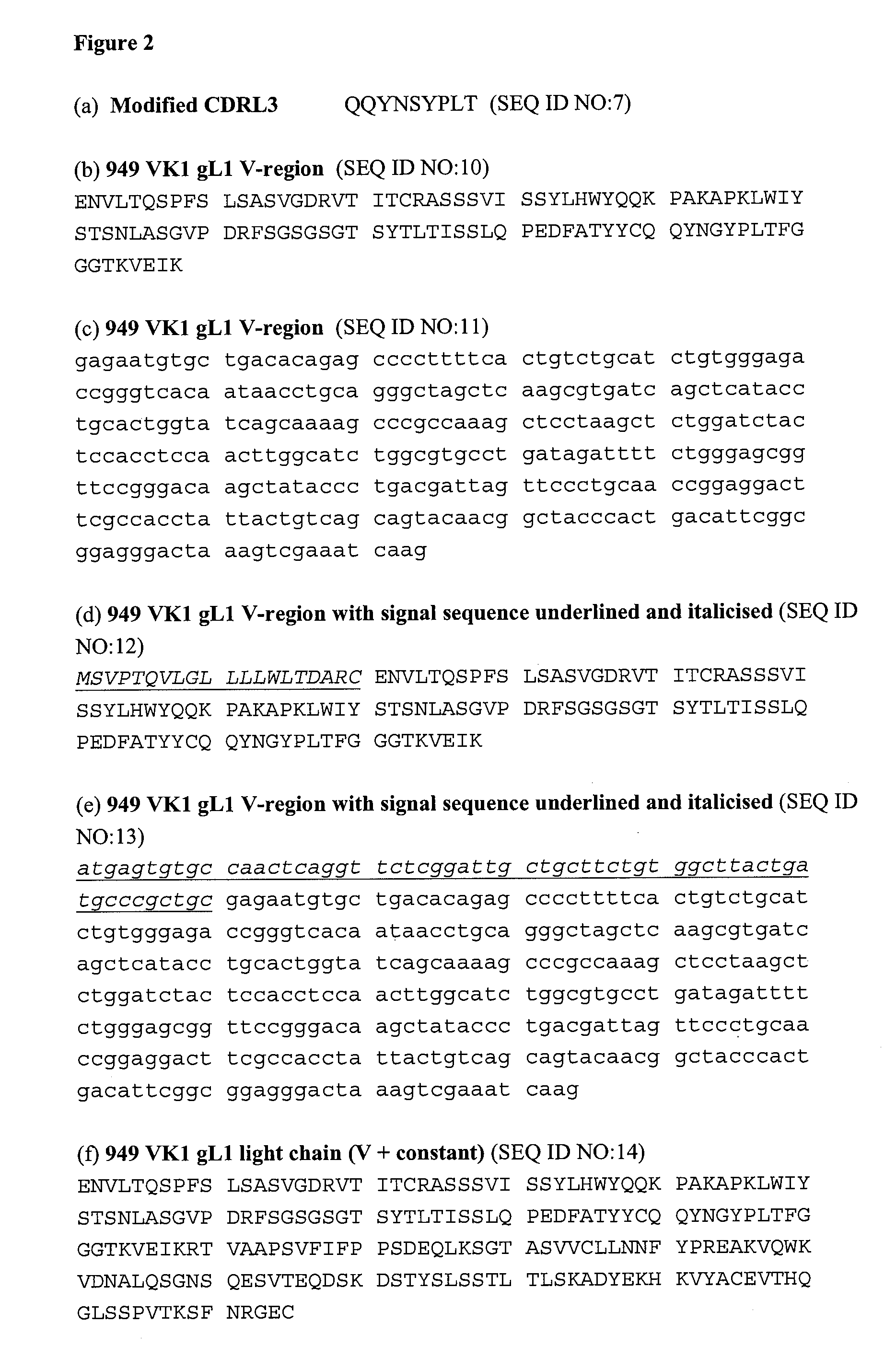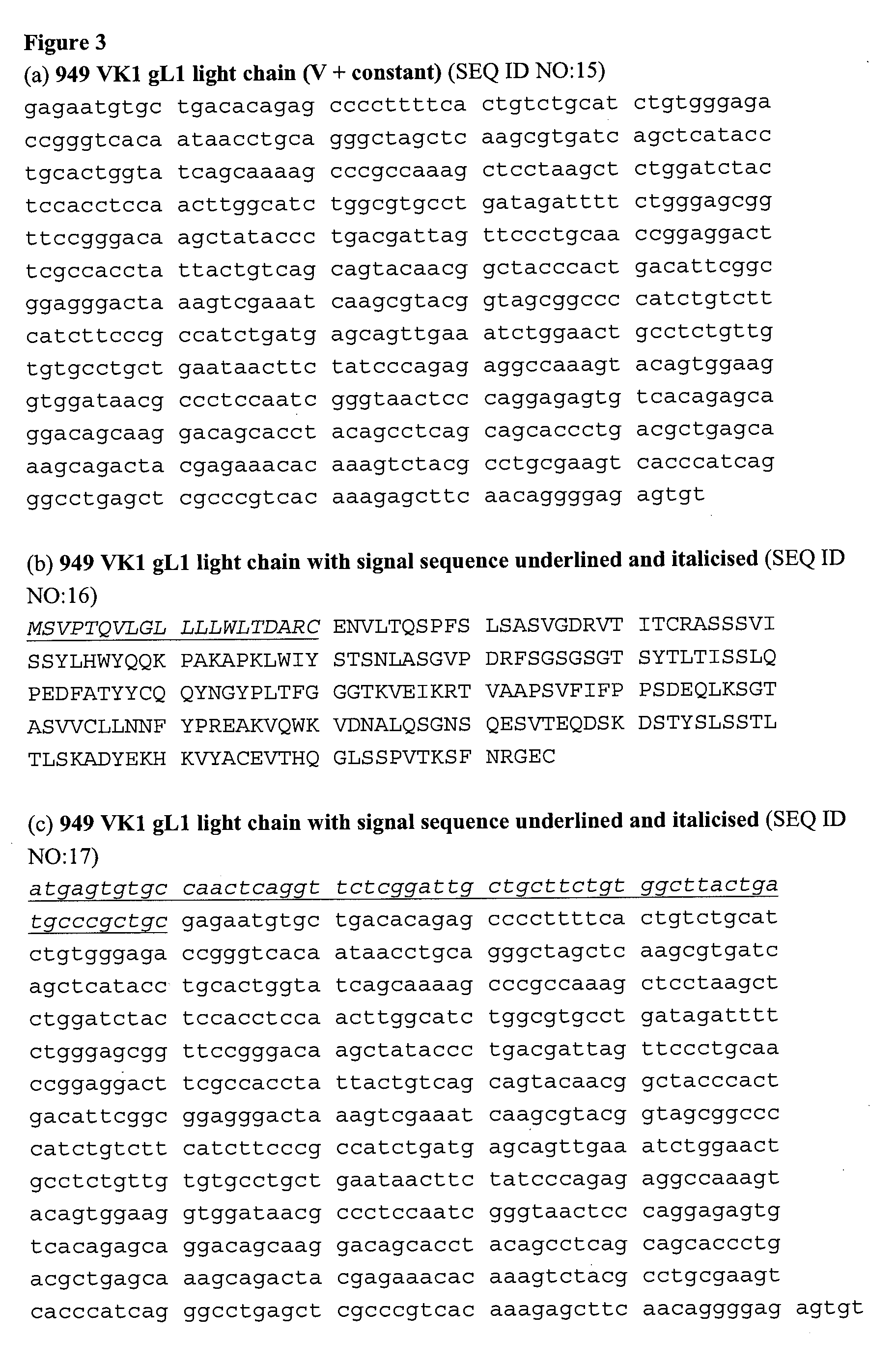PD-1 Antibodies
a technology of pd-1 and antibodies, which is applied in the field of pd-1 antibodies, can solve the problems of inability to clonally expand or produce optimal levels of effector cytokines,
- Summary
- Abstract
- Description
- Claims
- Application Information
AI Technical Summary
Problems solved by technology
Method used
Image
Examples
example 1
Methods for Generation of Anti-PD-1 Antibody Clone 19
[0314]The generation of antibody clone 19 has already been described in international application WO2010 / 029434.
1.1 Myeloma Cell Line
[0315]For fusion the myeloma cell line SP2 / 0-Ag14 from the German Collection of Microorganisms and Cell Cultures (DSMZ GmbH, Braunschweig) was used. This cell line is a hybrid between BALB / c spleen cells and the myeloma cell line P3x63Ag8. The cells have been described as not synthesizing or secreting immunoglobulin chains, being resistant to 8-azaguanine at 20 μg / ml, and not growing in HAT (Hypoxanthine, Aminopterin, Thymidine) medium. The SP2 / 0 cells are routinely maintained in tissue culture flasks in standard growth medium (with 10% FCS). A new aliquot of frozen SP2 / 0 cells was used after a period of 2 weeks in order to avoid the implementation of HGPRT-positive revertants. The myeloma cells were shown to be negative in all mycoplasma tests.
1.2 Antigens for Immunization and Screening
[0316]The rec...
example 2
Characterisation and Selection of Antibody 949
2.1 Rationale for Antibody Selection
[0325]In order to generate a therapeutic reagent which is able to transduce an inhibitory signal to T cells through PD-1, an agonistic anti-PD-1 monoclonal antibody was selected. Targeting the membrane proximal epitope with this antibody will ensure that it does not block the binding of the endogenous ligands for PD-1 (PD-L1 or PD-L2). Therefore, the agonistic antibody will act in addition to, and may potentiate, any natural inhibitory signals from the ligands being transduced through PD-1. Humanised versions of this antibody will have potential therapeutic utility in a wide range of human diseases which involve inappropriate levels of T or B lymphocyte activation.
2.2 Analysis of PD-1 Agonism Induced by Antibody 949 on Human CD4+ T Cells
[0326]To demonstrate that antibody 949 (parental variable regions, murine IgG1) can induce signaling through PD-1, it was tested for its ability to inhibit T cell recep...
example 3
Humanisation of Antibody CA051—00949
[0330]Antibody CA051—00949 was humanised by grafting the complementarity determining regions (CDRs, FIG. 1c) from the mouse antibody V-regions onto human germline antibody V-region frameworks. In order to recover the activity of the antibody, a number of framework residues from the mouse V-regions were also retained in the humanised sequence. These residues were selected using the protocol outlined by Adair et al. (1991) (Humanised antibodies. WO91 / 09967). Alignments of the mouse antibody (donor) V-region sequences with the human germline antibody (acceptor) V-region sequences are shown in FIGS. 17 and 18 together with the designed humanised sequences.
[0331]The CDRs grafted from the donor to the acceptor sequence are as defined by Kabat (Kabat et al. Sequence of proteins of immunological interest (1987). Bethesda, Md., National Institutes of Health, US), with the exception of CDR-H1 where the combined Chothia / Kabat definition is used (see Adair et...
PUM
| Property | Measurement | Unit |
|---|---|---|
| Fraction | aaaaa | aaaaa |
| Molar density | aaaaa | aaaaa |
| Molar density | aaaaa | aaaaa |
Abstract
Description
Claims
Application Information
 Login to view more
Login to view more - R&D Engineer
- R&D Manager
- IP Professional
- Industry Leading Data Capabilities
- Powerful AI technology
- Patent DNA Extraction
Browse by: Latest US Patents, China's latest patents, Technical Efficacy Thesaurus, Application Domain, Technology Topic.
© 2024 PatSnap. All rights reserved.Legal|Privacy policy|Modern Slavery Act Transparency Statement|Sitemap



